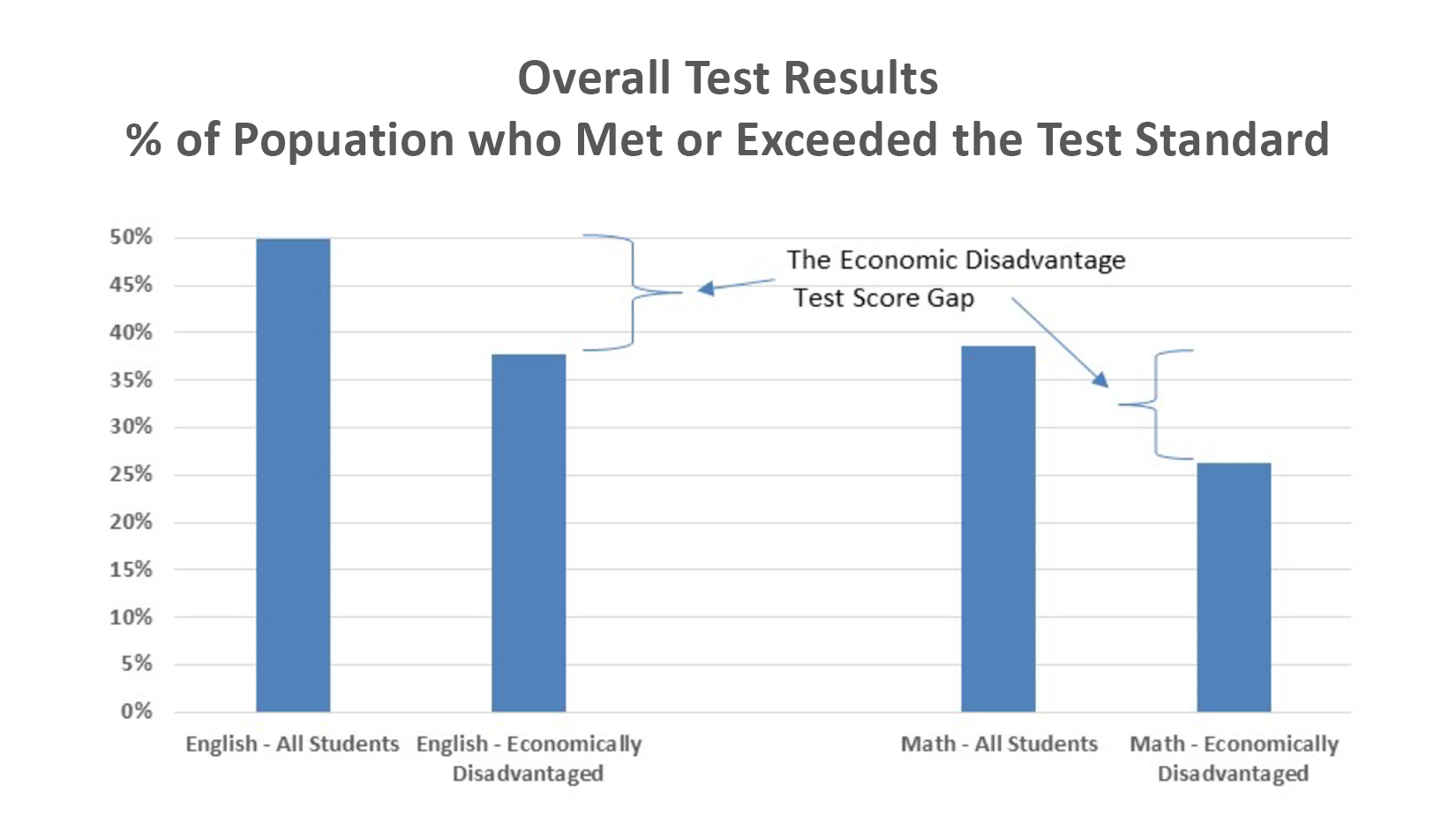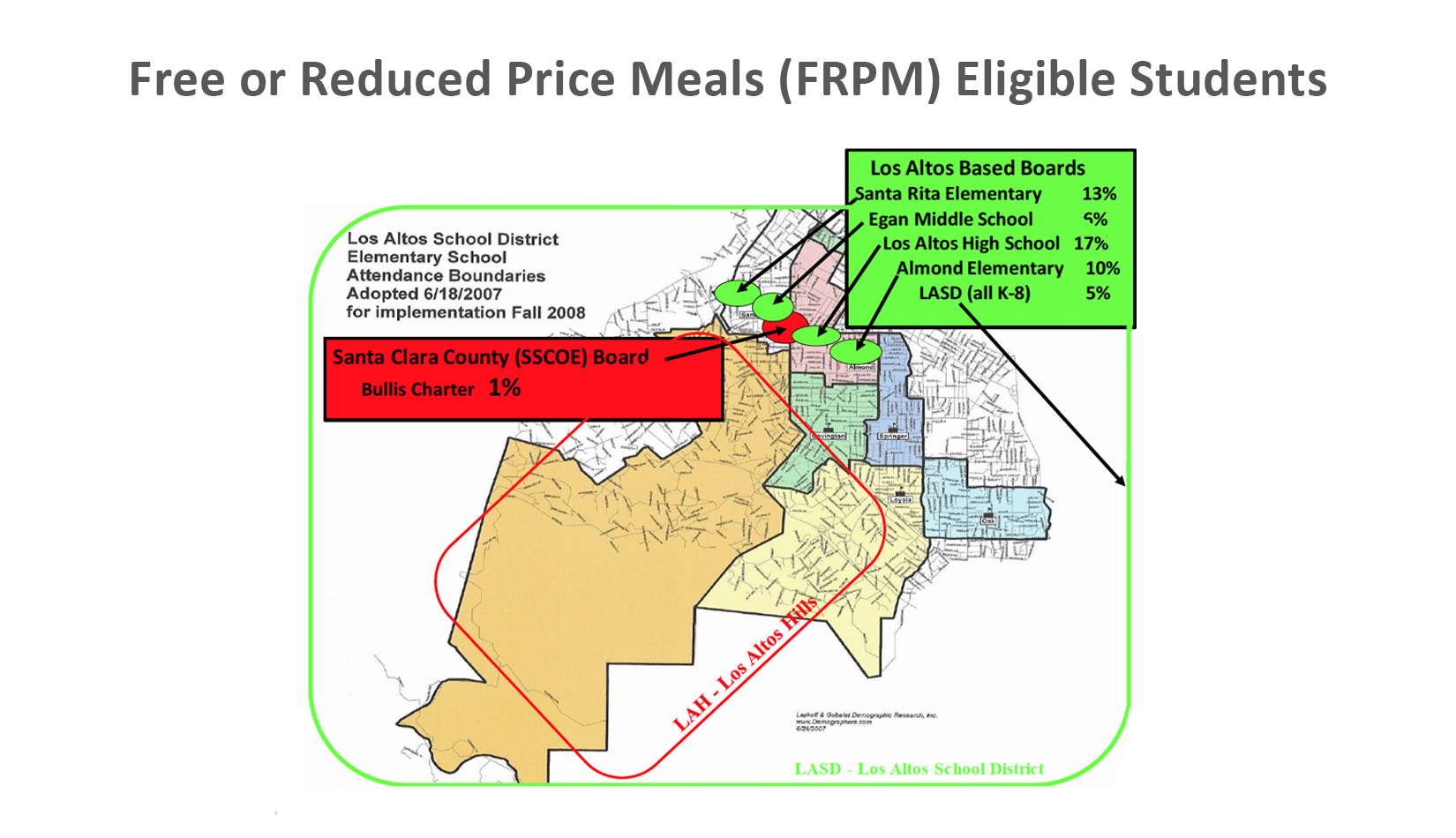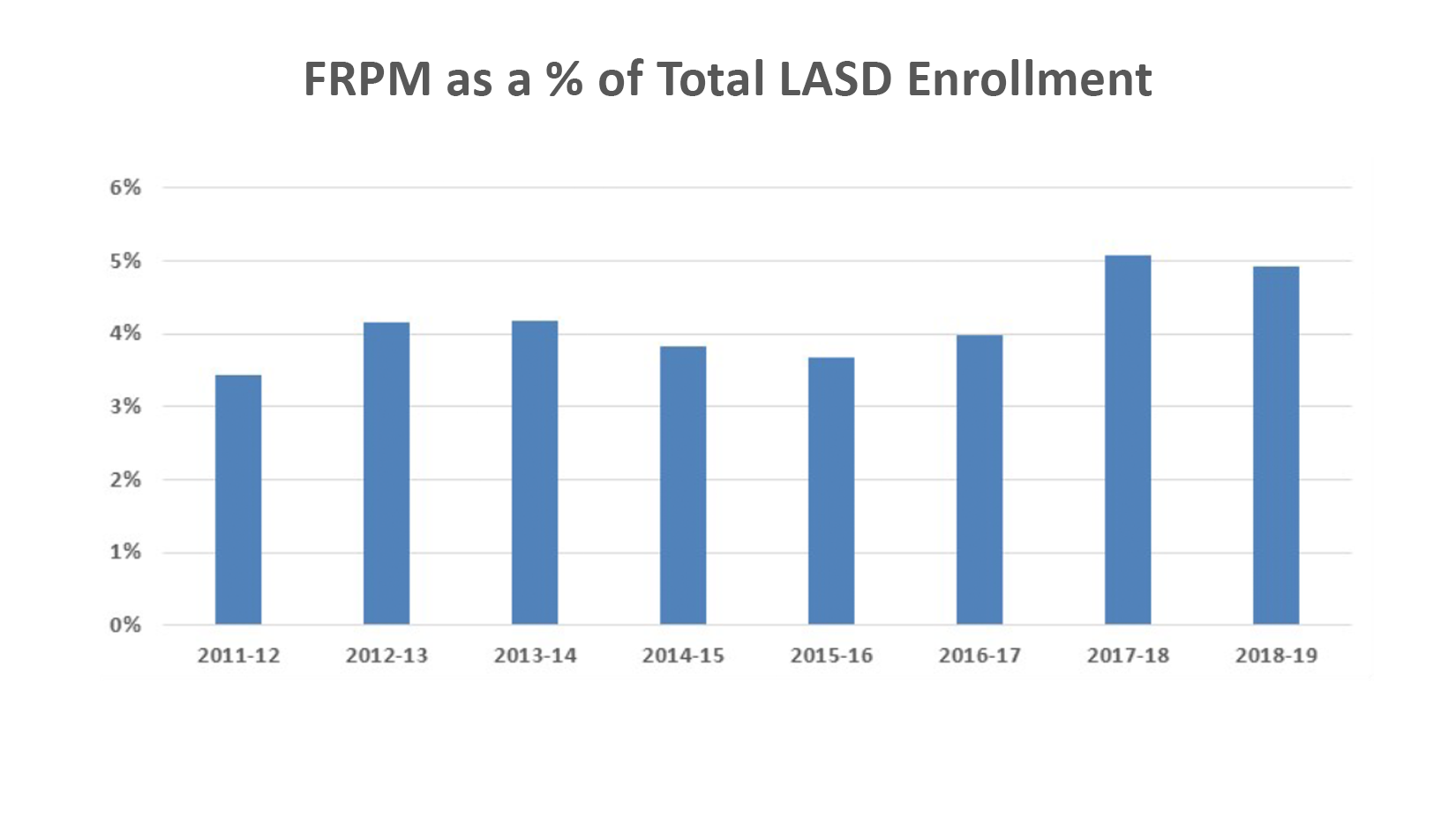economically disadvantaged
Economically Disadvantaged Students Face a Big Challenges and It Impacts Test Scores
In May of 2021, the Santa Clara County Board of Education voted 6-1 to reprimand Bullis Charter School for what it described as a chronic failure to proportionately enroll low-income students, Latino students and children with disabilities. How is BCS doing in meeting the board’s mandate for change? Our latest research shows that BCS has made little or no progress toward the goal of equality. You can read our latest report on BCS enrollment here.
This article examines the performance of Bullis Charter School in serving the needs of economically disadvantaged students in the Los Altos School District. It demonstrates that the current enrollment at BCS is significantly under-weighted in addressing the needs of these children compared with the district as a whole and particularly compared with nearby Almond and Santa Rita schools. This situation runs counter to the intent of California legislation for charter schools. It also begs the question of whether Bullis Charter School is fairly applying public funds to meet the educational needs of the entire district and argues for greater transparency and governmental oversight of BCS.
Economic disadvantage affects children on several levels, including physical, social-emotional and cognitive. According to the National Institutes of Health (NIH), “the stresses of poverty lead to impaired learning ability in children from impoverished backgrounds.”
Physical - Children’s ability to concentrate is affected by poor nutrition and poor health.
Social-Emotional - Children living in poverty often see themselves as victims of a system, lacking their own autonomy or ability to make choices that actually affect their lives. This poor sense of empowerment affects their focus, initiative and engagement in the classroom.
Cognitive Development - Long-term exposure to stress hormones as a result of living in or near poverty affects brain development. In particular, children living in poverty exhibit lower executive function (impulse control, emotional regulation, attention management, task prioritization, working memory, etc.) because their energy is focused on basic survival functions.
The impact on test scores due to economic disadvantage is significant. The two lowest scoring LASD schools are Almond and Santa Rita. These two schools have the largest proportion of students eligible for free and reduced price meals (FRPM). Adjusting the Almond and Santa Rita test scores, for the FRPM impact, results in test scores equal to or better than BCS. (*Note: Click on the charts and graphs below to enlarge them.)
There is a great deal of research that has been done by academics, think tanks, policy institutes, and political advocacy groups which concludes the number one predictor of academic test scores is the economic circumstances of the student’s household. The higher the economic circumstances, the better the test scores. If a school wants to have high academic scores, one category of student to under enroll is the economically disadvantaged.
The households in our community span the economic spectrum, from very wealthy to economically disadvantaged. The Los Altos School District (LASD) serves students residing in, parts of Los Altos Hills, Los Altos and parts of Mountain View. According to the 2010 census, Los Altos Hills median income is twice the median income of Mountain View. Mountain View has approximately 8% of their population living below the poverty line. In 2018 the Silicon Valley Business Journal noted “Los Altos Hills is officially the wealthiest town in America.”
Bullis Charter School (BCS) had its origin in Los Altos Hills. It was formed back in 2003 after a small neighborhood school (enrollment of 375) was closed in the budget squeezes after the dot.com bubble burst. The BCS Charter request was to use the LASD curriculum to serve the needs of up to 350 local neighborhood children. Fortunately, Los Altos School District (LASD) budget pressures eased, an $11 million renovation was completed, and five years later, in 2008, the neighborhood school reopened. At that point, the original BCS Charter was no longer relevant. In an effort to reinvent itself, the current version of BCS began to emerge.
Much has changed over the last decade. This discussion focuses on what has emerged as the current version of BCS, with a particular focus on the economic circumstances of the LASD student population relative to the BCS student population and the implications on academic test scores.
One Side of the Economic Coin – BCS Service of Economically Disadvantaged Students
BCS is under enrolled in LASD students who are eligible for Free and Reduced-Price Meals (FRPM).The California Department of Education uses FRPM as a key indicator of economic status. Meanwhile the Legislative Intent: 47601 (b) of the Charter school act is to “Increase learning opportunities for all pupils, with special emphasis on expanded learning experiences for pupils who are identified as academically low achieving.”
Only 1% of the BCS enrollment comprises students in need of expanded opportunities, whereas all other charter schools authorized by the Santa Clara County Office of Education serve much greater populations of FRPM students, with many schools serving FRPM populations in the 70th, 80th, and 90th percentiles. In fact, BCS serves just nine of the 209 FRPM students in the district. Seventy percent of these over 200 students live in walking distance from the campus in which BCS has resided for 15 years.
The nine LASD schools serve physical neighborhoods. Enrollment in these schools reflect the racial, ethnic and economic balance among the general population residing within each neighborhood.
Potentially the BCS Board has not embraced the clear statement in the BCS September 2008 Material Revision Request, "WHOM THE SCHOOL IS ATTEMPTING TO EDUCATE: The School seeks to educate all students in the state of California who wish to attend the School subject only to capacity, with a focus on serving students of the Los Altos Elementary School District. The school seeks to preserve a neighborhood school environment, serving kindergarten through eighth grade students."
Did the BCS Board cling to the notion that BCS was a neighborhood school, not responsible to also serve the most economically disadvantaged in LASD?Did the BCS Board see the BCS reference points as the neighborhood schools of Covington, Gardner Bullis, Loyola, Oak and Springer?
The BCS Board has been aware of their 2008 charter commitment to serve all the student of LASD, yet for the last 15 years, the BCS campus has been in close physical proximity to Santa Rita and Almond, both schools serving over 10% of their students who are eligible for FRPM.
Five years ago, in the August 2014 Renewal Petition, The BCS Board dropped the pretext that BCS is a neighborhood school. "WHOM THE SCHOOL IS ATTEMPTING TO EDUCATE: The School seeks to educate all students in the state of California who wish to attend the School subject only to capacity, with a focus on serving students of the Los Altos Elementary School District. The school seeks to preserve a neighborhood maintain a community school environment, serving kindergarten through eighth grade students."
FRPM eligible students have been in close physical proximity to the BCS campus. The population for these students is not a new challenge. Since 2011, there have been between 150 and 225 LASD students eligible for FRPM. The BCS Board did not take on this challenge.
The extreme embrace required to serve of these students, which is a typical priority of most charter schools, did not occur in 2008, or 2014, or 2016.What was done, was ineffective.During the last five years, the situation has not improved.
Does BCS See Themselves Serving Los Altos Hills or all of LASD?
Since 2008, Charter Revision and Charter Renewal and the 2014 Renewal Petition, and every one since then, has stated ALL students in LASD are "Whom the School Is Attempting to Educate".
Potentially the BCS Board had not embraced the clear statement in the BCS September 2008 Material Revision Request, " focus on serving students of the Los Altos Elementary School District."
Potentially the BCS Board had not embraced the clear statement in the August 2014 Renewal Petition dropping the pretext of being a neighborhood school, and reframing the school into a “community school”.
Potentially the BCS Board continued to cling, in their 2016 Renewal Petition, to the notion that BCS is a neighborhood school, not responsible to also serve the most economically disadvantaged in LASD by retaining an admission criterion stating:
“For no more than half the total available openings for each grade level, students who reside within the boundaries of the former Bullis-Purissima Elementary School attendance area, as drawn by Los Altos School District in the 2002-2003 school year, limited as follows - For incoming kindergarten classes for the 2019-2020 school year, there will be no preference for this category.”
Potentially the BCS Board believes the future of BCS is to serve students outside the LASD boundaries. All of the BCS Charter Petitions, unlike every other SCCOE Charter school petition, begins with the stated goal “The School seeks to educate all students in the state of California who wish to attend the School subject only to capacity.” In the 1,800 pages of charter school requests for Renewal or Material Revisions, there are innocuous sentences and paragraphs that mention that 1/3 of the applications BCS receives are from out-of-LASD and that BCS is advertising out-of-district. Another web posting will further explore this topic.
Potentially the BCS Board is so focused on growing enrollment, to make the case that that should be given the Egan campus, that they have missed the obvious oversite conclusion, that physical proximity will require BCS to serve at least 100 plus FRPM eligible students adjacent to Egan.
If a school wants to have high academic scores, one type of student to under enroll, are economically disadvantaged. This under enrollment allows a school to offer less services, it allows teachers to manage less distractions and, over time, it enables the school to develop/nurture a community in which the school culture manifests, unintentionally, a minority group isolation. The net effect is the opposite of embracing the economically disadvantaged.
The Flip Side of the Economic Coin – BCS Households
It is natural to flip the coin, one side being the economic circumstances of the students NOT being served, the other side of the coin being the economic circumstances of the students who ARE being served.
Unfortunately, the BCS Board has chosen to not be transparent in many ways. For example, it does not disclose enrollment by resident school district or resident city. Lack of transparency in a public institution breeds curiosity and perhaps a lack of trust. Potentially, understanding the other side of the coin, who the BCS Board has chosen to serve, will require some speculation.
Students enrolled in BCS seem to come from well-educated families, who are willing to make substantial financial contributions. Many families fund expensive field trips. Potentially, the family’s economic capacity to give has played a role in the review and qualification of applications to be included in the admission lottery.
The Residents of BSC Student Households are Able to Make Substantial Donations
As noted earlier, BCS was formed in 2003 after the smallest LASD school, a Los Altos Hills neighborhood school (enrollment of 375) closed due to an operating budget squeeze. Five years later, in 2008, after an $11 million renovation, LASD reopened the neighborhood school. At that point, the original BCS Charter was no longer relevant. In an effort to reinvent itself, the current version of BCS began to emerge.
A snapshot, four years into the of the reinvention was captured in the 2011 Bloomberg Magazine article titled “Taxpayers Get Billed for Kids of Millionaires at Charter School”. In that 2011 article the following was mentioned:
Bullis asks families to donate $5,000 per child each year
A foundation set up to help fund the school asks Bullis parents to donate at least $5,000 for each child they enroll. Those who can’t afford to pay should discuss the reason with a foundation member, “recognizing that other school families will need to make up the difference,” the foundation said on its website.
A former Bullis parent commented “They are very aggressive in asking parents for money … If you don’t pay it, word gets out that you aren’t doing your part.” Parents often refer to the payments as “tuition,” she said in an interview.
A member of the Santa Clara County Board of Education, said she received about 20 phone calls from parents who felt pressured to give because of repeated solicitation in school parking lots, e-mails and phone calls.
A Bullis parent, said he considered the $5,000 donation requested every year by Bullis to be “money well spent.” He previously sent his child to a private school where tuition was about $25,000 a year.
Community members recall that BCS had a “Wall of Shame”, which posted the names of those parents who did not donate the $5,000.
Another snap shot was in the 2016 BCS Petition showing the school receives donations of $4,500 per student per year.
The IRS 990 forms, filed as a requirement of maintaining a non-profit status, indicate aggregate donations to the foundation (calendar year) divided by BCS School enrollment (school year) average in the $4,500 to $5,000 range.
The Residents of BSC Student Households are Able to Fund Expensive Field Trips
BCS provides wonderful learning experiences for students by providing opportunities to go on field trips. “Program Field Trips” are provided to all students free of charge. “Non-Program Field Trips” are optional, not a part of the curriculum, not an educational activity and considered recreational. Although in the past, the expenses related to the “Non-Program Field Trips” were reported in the BCS School IRS reports, and occasionally aggregated with expenses such as teaching materials and various professional fees, they now appear to be managed by the Bullis Booster Club, a very impressive non-profit organization which provides many services for students. The reported expenses related to “Non-Program Field Trips” have been between $300,000 and $430,000 annually. Apparently, the key trips are offered to three grades and not all student participate.
The Residents of BSC Student Households are Very Well Educated
Which Correlates with High Income & High Net Worth
The educational accomplishments of the families of BCS students are very impressive. In the 2016 Renewal Petition, Bullis Charter School WASC/CDE Self-Study Report 2015 notes that 98% of the over 700 students came from a household with a parent who has earned a college degree and 86% also earned a graduate degree or higher. According to the 2010 census, these BCS parents have obtained a higher percent (98%) of bachelor degrees than percent of age 25 and older residents, in Los Altos Hills (84%), Los Altos (82%) and Mountain View (67%). As the table below indicates, an advanced/graduate degree, or higher, correlates with high income and family wealth.
Click on image to enlarge
“The relationship between education and wealth is also strong. Of course, earning a higher income makes saving easier, and saving is necessary to build wealth. Those with lower incomes have a flatter (non-humped) income pattern, which makes saving and paying down debt more difficult. But those with more education also tend to make financial decisions that contribute to building wealth.”
BSC Applications Were Shared with the BCS Foundation Before Student Acceptance
Potentially, in 2014, BCS considered, in the selection of applicants, those families more economically able to contribute to the BCS Foundation. There is mention in the 2014 renewal petition, a filing with the Santa Clara County Office of Education (Attachment 5: Bullis Charter School Recruitment and Enrollment Plan, page 6), that applicants’ names are kept confidential to anyone except the BCS Foundation. It is not obvious why sharing an applicant’s name with the BCS fund-raising organization is a part of the admission process. Most private schools, such as Stanford, at least make an effort to separate admission from fund raising development.
If this was a practice in the past, there appears to have been an effort to modify it. On the current BCS Foundation web site, in the FAQ tab, there is specific note “all donations are voluntary and have no bearing a child's enrollment or standing as a BCS student.” Certainly, that needs to be the school’s policy.
Unintended Consequences?
The economic separation between LASD students (served by neighborhood schools) and BSC (a district-wide charter, not a neighborhood school) may have occurred unintendedly. Potentially, the 2008 reinvention of BCS resulted in one short term goal leading to a short term decision, and after many iterations of pursuing immediate goals, when the cumulative impact is taken as a whole, the results are a troubling set of unintentional consequences. It is time to step back and take a second look at what we have become. It is time to ask a number of questions which will challenge our core values.
What are our core values related to our responsibility to place special emphasis on serving the educational needs of the economically disadvantaged?
What was the original goal, and the current goal, of the California charter movement?
Are we willing to stop the train of unintended consequences?
How do we collectively define and then support constructive roles for LASD and BCS to serve all of our students?







